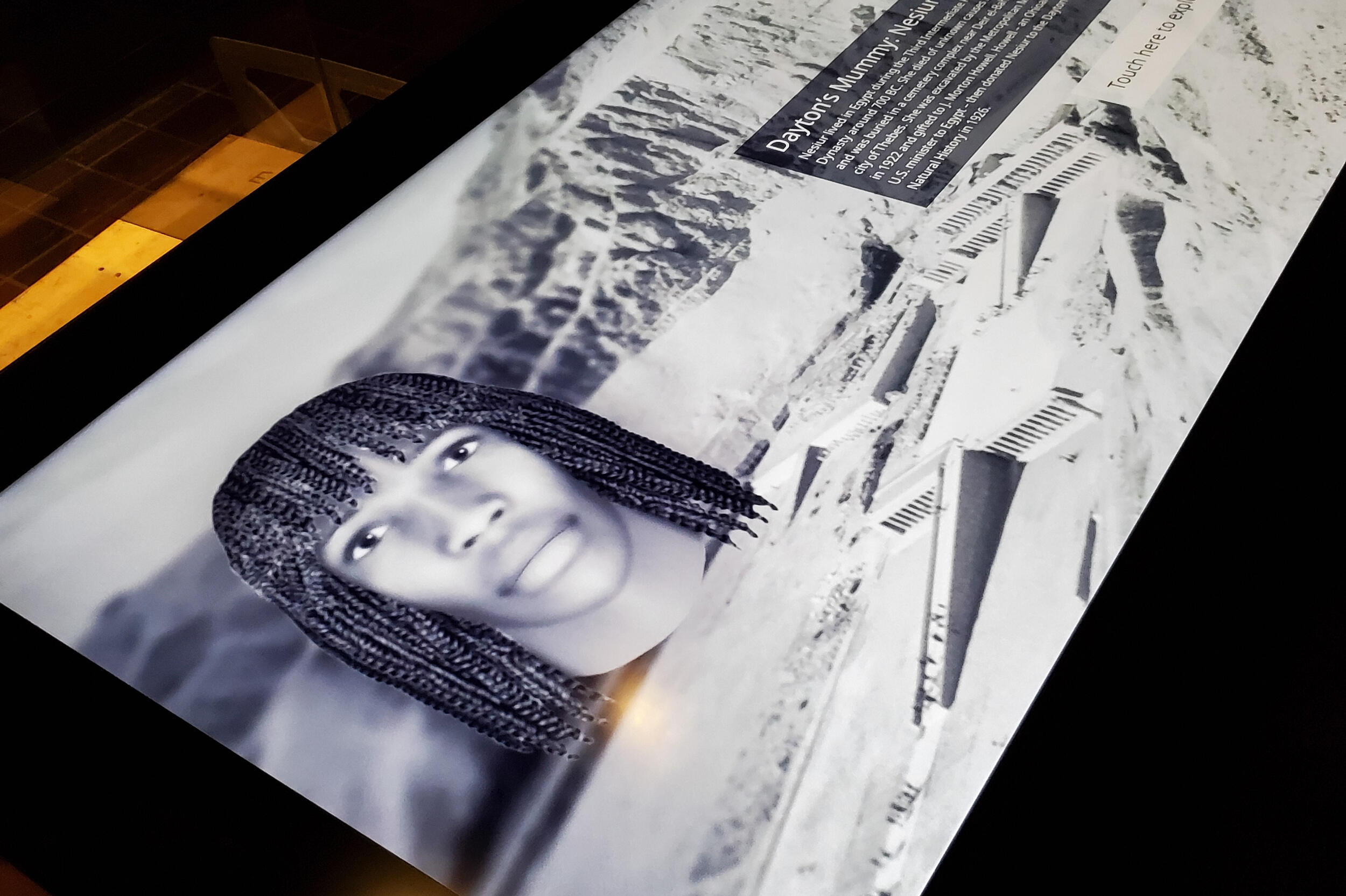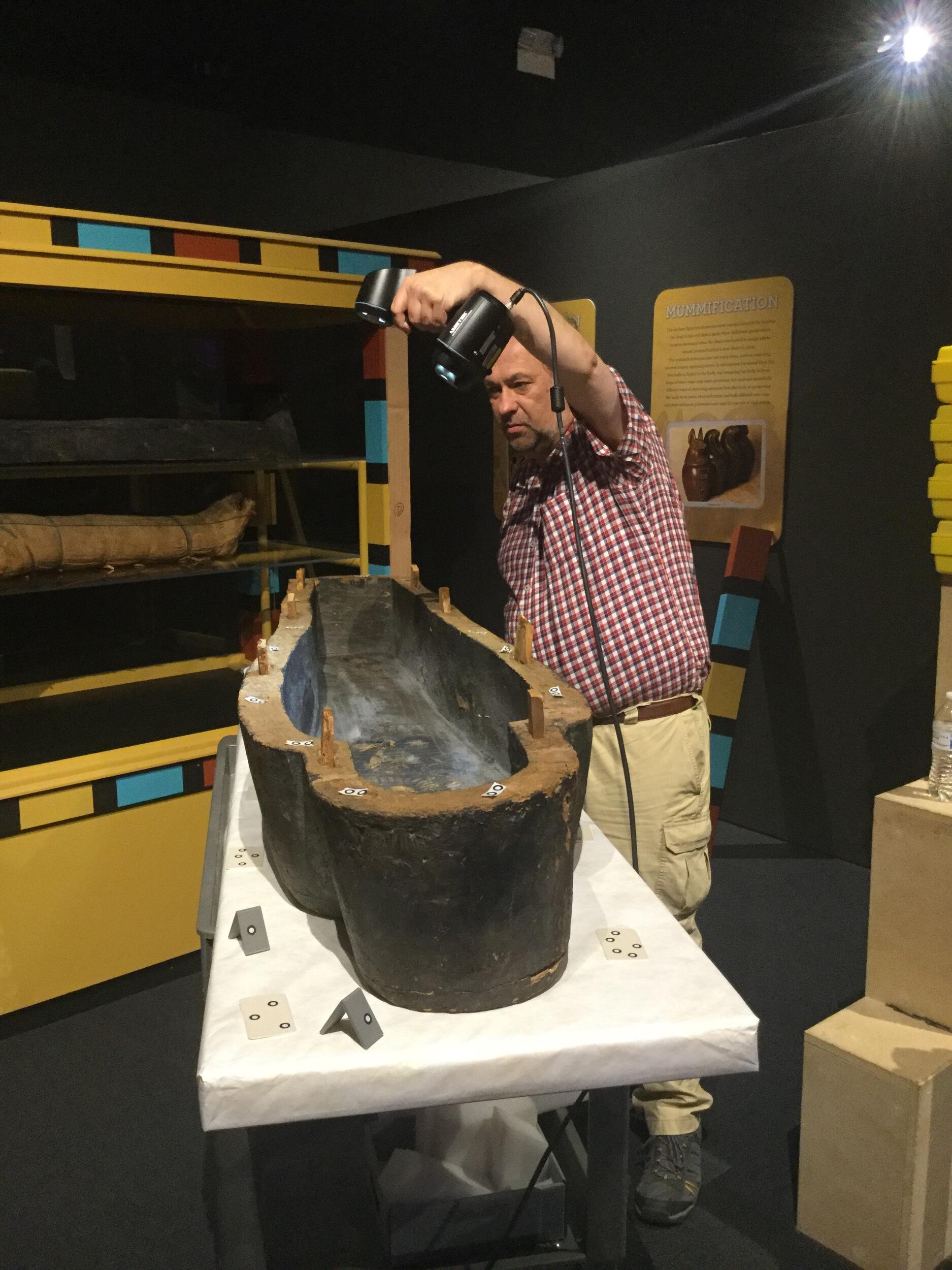
Feb. 25, 2020
A VCU student’s project revealed an ancient Egyptian mummy’s face. It’s now on display at a museum.
The mummy, Nesiur, was “digitally unwrapped” using CT scans. VCU student Mason Smith, along with a VCU forensic anthropologist, used the data to generate a facial approximation.
Share this story
A newly opened exhibition on ancient Egypt at an Ohio museum features a facial approximation of a nearly 3,000-year-old mummy created by a Virginia Commonwealth University student and faculty member, and also a 3D digital replica of the mummy’s sarcophagus that was generated by a VCU professor.
The exhibition at the Boonshoft Museum of Discovery in Dayton displays a digital approximation of the face of the mummy, Nesiur, that was generated based off CT scan data. It was created by Mason Smith, an anthropology major who graduated from VCU in December, with the help of Terrie Simmons-Ehrhardt, a faculty member in VCU’s Department of Forensic Science in the College of Humanities and Sciences.
“I decided I’d like to complete a modern facial approximation for [VCU’s] Undergraduate Research Opportunity Program last year,” Smith said. “[We set out to] digitally approximate what Nesiur, a 3,000- year-old female Egyptian mummy, may have looked like in life. I would have never expected it to go on exhibition, but I am so excited that my little project has come to life in such a big way.”
The Boonshoft Museum linked up with VCU in 2018 when it invited Bernard Means, Ph.D., a teaching assistant professor of anthropology in the School of World Studies, to visit and 3D scan Nesiur’s sarcophagus.
“The goal was to create a digital file that could be integrated with the CT scan recently made of the mummy into an interactive touch table,” said Means, director of VCU’s Virtual Curation Laboratory, at which Means and his students create 3D digital models of historical, archaeological and paleontological objects used for teaching, research and public outreach.
The museum provided Means and Simmons-Ehrhardt with CT data to visualize Nesiur in ways previously impossible.
“We effectively digitally unwrapped the mummy, providing a sense of discovery and increasing our understanding of who she was in life,” said Jill E. Krieg-Accrocco, curator of anthropology and exhibitions for the Dayton Society of Natural History, the parent organization of the Boonshoft Museum of Discovery. “This data provides us a much more effective way to educate the public while also remaining culturally sensitive to the display of human remains.”
Nesiur’s coffin and style of mummification suggests she lived during the 25th dynasty (circa 700 B.C.). She was excavated at the Deir el Bahri site in western Thebes in 1922 by H.E. Winlock of the Metropolitan Museum of Art in New York. She was donated to the museum in 1926.

Simmons-Ehrhardt extracted the skeletal data from Nesiur’s CT scan, allowing Means and his students to 3D print it and Smith to work on the facial approximation with software called FaceGen.
“I generated the 3D model of the skull from the CT scan, adjusted the mandible into anatomical position because it was no longer in anatomical position, and generated frontal and profile images of the skull annotated with facial feature guidelines for her to import into FaceGen,” Simmons-Ehrhardt said. “FaceGen demo does not allow the import of a 3D skull model, but [Smith] was able to import the 2D frontal and profile images of the skull as background images and adjust the facial features in 3D using the software tools according to the guidelines I gave her to make the face ‘fit’ over the skull images.”
FaceGen contains a database of 3D faces, so Smith was able to adjust facial features until they lined up with Nesiur’s skull.
“Not only was it amazing to work with somebody as intelligent and accomplished as Terrie [Simmons-Ehrhardt], but also the feeling of recreating the recognizable face of a woman who lived so long ago was indescribable,” said Smith, who works in the Virtual Curation Laboratory as lab manager and artistic director. “It really felt like putting together an image of the past.”
Simmons-Ehrhardt said she is excited to see Smith’s work put on display.
“I think Mason did a great job and it was a fun process to help her with applying free 3D technology to a historical facial approximation since I normally work with forensic cases,” she said.
Also on display is the digital 3D replica of Nesiur’s sarcophagus that was created by Means. A hands-on display allows museumgoers to interact with the sarcophagus in a dynamic way, whereas they would not have been able to touch the original artifact.
“A more traditional display would simply show the mummy and her sarcophagus behind glass,” Means said. “Here, people can interact with both and see features that would be obscured in a traditional display. I think this particular exhibit really highlights the potential for digital technologies for giving viewers, and even museum personnel, a way to go behind the scenes. I simply find it amazing that people can digitally travel through the lid of the sarcophagus, peer under the mummy's wrappings and see the designs along the inside base of the coffin.”
The Boonshoft Museum reached out to Means because the Virtual Curation Laboratory has a long record of working with museums across the U.S. and in India for using digital scanning and 3D printing technologies for exhibits and public outreach.
“This particular project was possible because of the skills we have honed in the VCL, and the partnerships we have made across our campus and with museums all over,” Means said. “These include VCU forensic anthropologist Terrie Simmons-Ehrhardt, who not only extracted the skeletal data from Nesiur’s CT scan so that we can print it, but also worked with now VCU alumnae Mason Smith to create a facial approximation, which we have also 3D printed.”
Even people who can’t make it to the museum can still interact with some elements of the new exhibit, as the Boonshoft Museum has granted permission to the Virtual Curation Laboratory to place the 3D scans and the reconstruction of Nesiur online. To see them, visit: https://sketchfab.com/virtualcurationlab/collections/ancient-egypt-exhibit-at-boonshoft-museum.
Subscribe to VCU News
Subscribe to VCU News at newsletter.vcu.edu and receive a selection of stories, videos, photos, news clips and event listings in your inbox.










